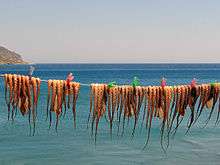Food drying

Food drying is a method of food preservation in which food is dried (dehydrated or desiccated). Drying inhibits the growth of bacteria, yeasts, and mold through the removal of water. Dehydration has been used widely for this purpose since ancient times; the earliest known practice is 12,000 B.C. by inhabitants of the modern Middle East and Asia regions.[2] Water is traditionally removed through evaporation (air drying, sun drying, smoking or wind drying), although today electric food dehydrators or freeze-drying can be used to speed the drying process and ensure more consistent results.

Food types


Many different foods can be prepared by dehydration. Meat has held an historically significant role. For centuries, much of the European diet depended on dried cod—known as salt cod, bacalhau (with salt), or stockfish (without). It formed the main protein source for the slaves on the West Indian plantations, and was a major economic force within the triangular trade. Dried shark meat, known as Hákarl, is a delicacy in Iceland, while dried reindeer meat is a traditional Sami food. Currently popular dried meats include prosciutto (a.k.a. Parma ham), bresaola, and beef jerky.
Fruits change character completely when dried. The plum becomes a prune, the grape a raisin. Figs and dates are also transformed into new, different products that can either be eaten as they are or rehydrated. However, dehydrated fruit may be nutritionally inferior to its source. Dehydrated grapes have been shown to be depleted in antioxidants (Vitamin C, E, ORAC) and B vitamins.[3]
Freeze-dried vegetables are often found in food for backpackers, hunters, and the military. Garlic and onion are often dried. Edible mushrooms, as well as other fungi, are also sometimes dried for preservation purposes or to be used as seasonings.
Preparation
Home drying of vegetables, fruit and meat can be carried out with electrical dehydrators (household appliance) or by sun-drying or by wind. Preservatives such as potassium metabisulfite, BHA, or BHT may be used, but are not required. However, dried products without these preservatives may require refrigeration or freezing to ensure safe storage for a long time.
Industrial food dehydration is often accomplished by freeze-drying. In this case food is flash frozen and put into a reduced-pressure system which causes the water to sublimate directly from the solid to the gaseous phase. Although freeze-drying is more expensive than traditional dehydration techniques, it also mitigates the change in flavor, texture, and nutritional value.In addition, another widely used industrial method of drying of food is convective hot air drying. Industrial hot air dryers are simple and easy to design, construct and maintain. More so, it is very affordable and has been reported to retain most of the nutritional properties of food if dry using appropriate drying conditions.[4]
Other methods

There are many different methods for drying, each with their own advantages for particular applications; these include:
- Bed dryers
- Drum drying
- Freeze Drying
- Shelf dryers
- Spray drying
- Sunlight
- Commercial food dehydrators
- Household oven
Historically, in some agricultural areas specially designed buildings were constructed to dry agricultural products indoors; depending on the climate, heat could be supplied by a furnace of some kind, or natural wind could be used. In Britain, and other hops-growing regions in Europe, oast houses were built to dry hops using the heat of a kiln. In Xinjiang, grapes are dried into raisins in special ventilated sheds known as chunche. In the Faroe Islands, a drying shed known as hjallur would often be used to dry mutton.
See also
References
- ↑ Grandidier (1899), p. 521
- ↑ "Historical Origins of Food Preservation". Accessed June 2011.
- ↑ "Grapes Vs. Raisins: A Nutritional Analysis - Yahoo! Voices". voices.yahoo.com. 2011-09-26. Retrieved 2013-07-09.
- ↑ "Modeling the thin-layer drying of fruits and vegetables: A review". Wiley-Blackwell. 2016-02-04. Retrieved 2016-02-08.
Bibliography
- Grandidier, A. (1899). Guide de l’immigrant à Madagascar (in French). Paris: A Colin et cie.
External links
| Wikimedia Commons has media related to Dried food. |
- National Center for Home Food Preservation, drying section: http://nchfp.uga.edu/how/dry.html
|
